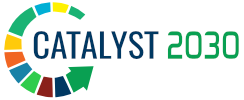Catalyst 2030 Awards
For Systemic Change
Bilaterals and Multilaterals Judging Criteria | 2022
About the Award
This award celebrates teams or project units within bilateral/multilateral donors that have deployed capital to support project(s) or initiative(s) to achieve systems change. Within this award, there are four sub-categories that inform the final award, leveraging the Catalyst 2030 Funder Diagnostic Survey. These categories were informed by the Embracing Complexity Report. This award is the first of its kind to focus on the funding of systems change entrepreneurs.
Since bilaterals and multilaterals can be confusing, here is an accepted definition of the two categories:
Bilaterals
Bilateral organisations receive funding from the government in their home countries and use the funding to aid developing countries. For example: NORAD, SIDA, FCDO, DANIDA, Dutch Ministry of Foreign Affairs (MFA), USAID, Australian Department of Foreign Affairs and Trend (DFAT), Global Affairs Canada (GAC) and so on.
Multilaterals
Multilateral organisations obtain their funding from multiple governments and spend it on initiatives in various countries. Some examples include: WHO, UNICEF, UN Women, UNDP, African Development Bank and World Bank.
1. Leader in Learning: Embrace a Systems Mindset
Demonstrate public promotion of lessons learned in supporting systems change. Embrace failure as a learning process, and fund research to support learning and better practices for systems change.
2. Leader in Trust: Support evolving paths to systems change, prepare for long-term engagement
and provide multi-year unrestricted funding. Take time to build trust with their grantees including through regular honest and respectful discussions, and/or simplify and right-size the application and reporting effort.
3. Leader in Partnership: Work in true partnership
Acknowledge and work against power dynamics, demonstrate an approach that is relational over transactional, listen to what systems change leaders need and provide targeted financial and non-financial support in an effort to co-create the desired impact.
4. Leader in Collaboration: Collaborate with other stakeholders
Coordinate action, build strong networks with other system stakeholders, and/or leave the leading role to systems change leaders. This includes support for collaboration infrastructure – for example funding for coordination facilities, funding for the overhead associated with collaboration.
Award Specific Criteria
The criteria are crafted from the questions in the Funder Diagnostic survey. The goal for these criteria is to allow for a quantitative evaluation of nominations. This will also drive additional responses to the funder diagnostic survey, supporting us to have enough responses to be able to conduct analysis. Each of the criteria below are crafted as multiple choice questions, to allow for clear scores, with weights ascribed to each of them.
Category |
Criteria |
| Leader in Learning | 1. How do you respond to failure to achieve expected outputs or outcomes? |
| 2. To what extent do you use practices that help you navigate the complexity of systems change (e.g. intentionally conducting and learning from experiments)? | |
| Leader in Trust | 1. Do you include social change organisations and/or social entrepreneurs in design/oversight of the work and consider them equal partners from planning to implementation? |
| 2. On average, what portion of your annual financial contribution is granted/invested without project or program restrictions? (Include general support grants/investments to entire organisations, or to specific initiatives within large institutions.) | |
| 3. How transparent are you about project selection, financing and implementation; and how burdensome are your reporting processes? | |
| Leader in Partnership | 1. To what extent are citizen engagement and oversight central components of your approach to systems change? |
| 2. To what extent do you allow your strategy to be influenced by grantees/investees? | |
| 3. After a grant/investment has been made, to what extent are you open to grantees/investees making changes to their original plan? | |
| 4. When choosing an initiative to support, how much uncertainty are you typically comfortable with? | |
| 5. To what extent do you support grantees/investees in building their capacities (e.g. leadership coaching, strategic planning)? | |
| Leader in Collaboration | 1. To what extent do you enable coordination among grantees/investees or with other stakeholders (e.g. business, government, media)? |
| 2. How do you typically find new grantees/investees to support? | |
| 3. To what extent do you support grantees/investees that weave together partnerships, coalitions, networks, or movements within a system? | |
| 4. When do you typically collaborate with other funders? |
Eligibility
Units or teams within bilateral or multilateral agencies that fulfil the criteria above.
